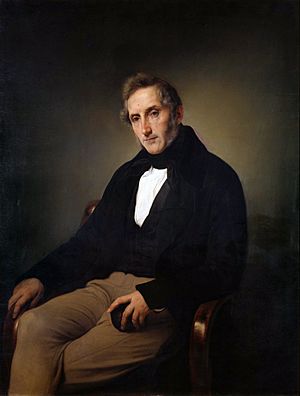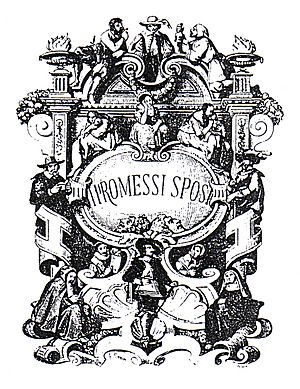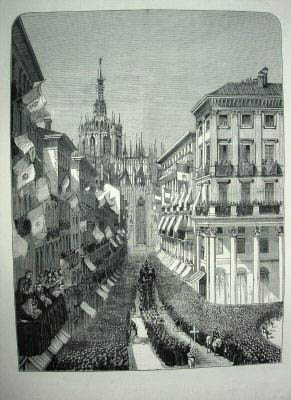Alessandro Manzoni facts for kids
Quick facts for kids
Alessandro Manzoni
OCI, OSG, OSML, PM
|
|
|---|---|

|
|
| Senator of the Kingdom of Italy | |
| In office 29 February 1860 – 22 May 1873 |
|
| Monarch | Victor Emmanuel II |
| Personal details | |
| Born |
Alessandro Francesco Tommaso Manzoni
7 March 1785 Milan, Duchy of Milan |
| Died | 22 May 1873 (aged 88) Milan, Italy |
| Resting place | Monumental Cemetery of Milan |
| Nationality | Lombard |
| Spouses |
Enrichetta Blondel
(m. 1808; she d. 1833)Teresa Borri
(m. 1837; she d. 1861) |
| Children | Giulia Claudia (1808–1834) Pietro Luigi (1813–1873) Cristina (1815–1841) Sofia (1817–1845) Enrico (1819–1881) Clara (1821–1823) Vittoria (1822–1892) Filippo (1826–1868) Matilde (1830–1856) |
| Parents | Pietro Manzoni and Giulia Beccaria |
| Relatives | Cesare Beccaria (grandfather) Massimo d'Azeglio (son-in-law) |
| Occupation | Writer, poet, dramatist |
| Writing career | |
| Period | 19th century |
| Genre | Historical fiction, tragedy, poetry |
| Subject | Religion, politics, history |
| Literary movement | Enlightenment Romanticism |
| Years active | 1801–1873 |
| Notable works |
|
| Signature | |
Alessandro Manzoni (born March 7, 1785 – died May 22, 1873) was a famous Italian writer. He was a poet, novelist, and thinker. Manzoni is best known for his novel The Betrothed (original title: I promessi sposi). This book is considered one of the greatest works in world literature.
The Betrothed also played a big role in Italy's history. It helped unite the country by promoting a shared Italian language. Manzoni's work helped make modern Italian common across the whole country. He was also a supporter of Liberal Catholicism in Italy.
Contents
Early Life of Alessandro Manzoni
Manzoni was born in Milan, Italy, on March 7, 1785. His father, Pietro, came from an old family in Lecco. His mother, Giulia, was the daughter of Cesare Beccaria, a well-known writer and philosopher. Giulia herself was also a talented writer.
When Alessandro was seven, his parents separated. His mother moved to Paris. Because of this, Alessandro grew up in different religious schools. He wasn't always the best student. But by age fifteen, he discovered a love for poetry. He wrote two good poems around that time.
After his father passed away in 1807, Manzoni lived with his mother in Auteuil, France. He spent two years with a group of writers and thinkers. Here, he became very interested in liberalism, which is about individual rights and freedoms. He also inherited a large property, the villa of Brusuglio, which became his main home.
In 1806–1807, Manzoni published his first poems. One was called Urania, written in a classical style. The other was a poem about the death of Count Carlo Imbonati.
Manzoni's Family Life and Faith
In 1808, Manzoni married Henriette Blondel. She was the daughter of a banker from Geneva. Henriette was from a Calvinist family, but in 1810, she became a Roman Catholic. Her decision greatly influenced Manzoni. That same year, he had a deep religious experience. This led him to become a strong Catholic.
Manzoni's marriage was a happy one. For many years, he lived a quiet life at home. He spent his time writing and taking care of his farm in Lombardy. During this period, he wrote the Inni sacri, which are sacred poems. He also wrote a book on Catholic morals called Osservazioni sulla morale cattolica.
In 1818, Manzoni had to sell his family inheritance. His money was lost by a dishonest agent. But he showed great kindness to his peasants. They owed him a lot of money. He not only canceled their debts but also let them keep their entire maize harvest.
In 1819, Manzoni published his first play, Il Conte di Carmagnola. This play broke many old rules of theater. It caused a lot of discussion. Even the famous German writer Johann Wolfgang von Goethe defended it. When Napoleon died in 1821, Manzoni wrote a powerful poem called Il Cinque maggio (The Fifth of May). It is one of the most famous Italian poems.
The Betrothed Novel
Manzoni started writing his most famous novel, The Betrothed (I promessi sposi), in 1821. He finished the first version in September 1823. The book was published between 1825 and 1827. It quickly made him a very famous writer. Many people agree it is his greatest work. It also helped set the standard for the modern Italian language.
The novel is known for its amazing characters. These include Lucia, the main heroine, and Padre Cristoforo, a kind friar. There is also the good cardinal of Milan, Cardinal Carlo Borromeo. Manzoni created these characters to show his ideal of pure Christianity. He also wrote about everyday people with humor and understanding.
In 1822, Manzoni published his second play, Adelchi. This play was about the fall of the Lombard rule in Italy. It also hinted at the Austrian rule at the time. After these works, Manzoni mostly stopped writing new literary pieces. However, he spent a lot of time revising The Betrothed. He rewrote it in the Tuscan dialect of Italian. This helped make that dialect the basis for modern Italian. In 1840, he republished the novel with a historical essay. This essay was called Storia della colonna infame. It was about the 17th-century plague in Milan, which is an important part of the novel. He also wrote a short book about the Italian language.
Manzoni's Views on Politics and Money
Manzoni strongly supported the unification of Italy. He even became a member of the Italian Senate. Before and after his religious conversion, Manzoni's political ideas were generally liberal. This means he believed in freedom and individual rights.
His time in France helped him understand economics well. He knew the works of famous economists like Jean-Baptiste Say and Adam Smith. He wrote many notes on the economic books he read.
His understanding of economics is clear in The Betrothed. Especially in Chapter 12, where he describes a famine in Lombardy. Famous economists like Luigi Einaudi and Deirdre N. McCloskey have praised this chapter. They called it one of the best writings on economics ever.
Manzoni's Later Life and Legacy
Manzoni faced many personal losses. His wife died in 1833. Before and after this, several of his children and his mother also passed away. In 1837, he married again to Teresa Borri. But Teresa also died before him. Out of his nine children from both marriages, only two outlived him.
In 1860, King Victor Emmanuel II made him a senator. The death of his oldest son, Pier Luigi, in April 1873, was a final blow. Manzoni had already been weakened by a fall in January. He hit his head while leaving a church. He died five months later from a brain infection.
His funeral was a very grand event at the Milan Cathedral. His body was taken to the Cimitero Monumentale in Milan. A huge crowd followed, including royal princes and important government officials. The famous composer Giuseppe Verdi wrote his Requiem to honor Manzoni's memory. In recent times, Google has honored him twice with a special Google Doodle.
See also
 In Spanish: Alessandro Manzoni para niños
In Spanish: Alessandro Manzoni para niños



